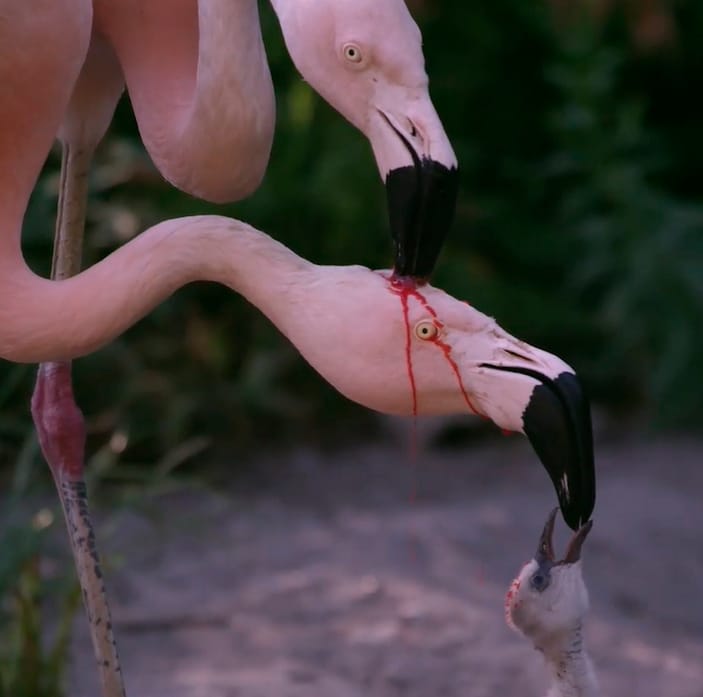There is a widespread belief that the unusual red color of flamingo bird milk is due to the addition of blood to it - either from the body of a nursing parent, or from the pecked head of a second one. We decided to check how correct such explanations are.
Information about bloody diet chicks flamingos possible find on various resources, from the media and popular science sites to blog posts. For example, RIA Novosti tells about it this way: “Vegetable milk contains a little blood, since vessels burst in the esophagus of birds. It is noteworthy that this only happens during the feeding period. Scientists believe that mineral-rich blood is an essential component of chick nutrition.” Similar version puts forward “Sputnik Kyrgyzstan”: “When flamingos feed their chicks, blood vessels burst in their esophagus. The blood mixes with the plant milk and it turns red.” Entertainment users portals and social networks They even give exact figures - supposedly flamingo milk consists of 23% of the parent’s blood. They write about blood in bird milk and portals about nature, as well as official website Moscow Zoo.
Flamingos, like some other birds (pigeon, parrots, emperor penguins), during the period of feeding offspring produce a special secret is goiter, or bird's milk. Moreover, as a rule, both parents do this, and not just the female (exception - Emperor penguins, in which only the male produces crop milk). Goiter milk contains There is a lot of protein and fat, while it contains almost no carbohydrates and completely lacks lactose, which is characteristic of most mammals. In flamingos, this secretion is more liquid, and, for example, in pigeons it has a curdled consistency. Flamingo fed chicks with crop milk up to six months, for one feeding of the chick Maybe eat a portion equal to almost 20% of your body weight.
In 2014, researchers at the Fort Worth Zoo in Texas studied composition of crop milk of the American (red) flamingo, living on the Gulf Coast. The researchers caught non-flying individuals at the age of six to seven weeks, weighing more than a kilogram and with a visually full crop (that is, their parents had recently fed them and the nutritional secretion had not yet been digested and absorbed). 30 ml of crop milk was taken from each individual and the resulting samples were carefully examined. Milk was high in protein (from 22% to 50%), fat (from 30% to 75%), and also contained calcium, phosphorus, magnesium, potassium, sodium, iron and zinc. There were no traces of blood cells in the goiter milk.
The researchers found out that the substance got its red color for a completely different reason - pigments from the carotenoid group, beta-carotene and canthaxanthin, were present in flamingo milk. Beta carotene is also responsible, for example, for the orange color of carrots and the red color of tomatoes, and canthaxanthin gives specific coloring of crustaceans, some types of fish, chanterelle mushrooms, as well as the yolk of eggs in some birds. Canthaxanthin is also widely used in the food industry (for example, giving bright color for salmon meat), in medicine (to stabilize state patients with porphyria, eczema, psoriasis and vitiligo) and in cosmetics (as a component for tablets self-tanners).
Exactly carotenoids, obtained from crustaceans and algae - the main part of the flamingo's diet - and paint their feathers are in shades of pink and red. These same pigments, as it turned out, are also present in the nutritious secretion of lactating individuals, giving it a unique bloody tint. And although no one has studied the walls of the esophagus of adult flamingos for the presence of injuries and ruptures, the absence of traces of blood components in goiter milk convincingly proves that it is definitely not present in the composition. Moreover, since dietary carotenoids appear to be concentrated in the crop milk of nursing birds, less of them are transferred to the rest of the body, causing flamingo feathers to fade slightly during feeding.
Thus, there is no reason to believe that flamingo chicks actually receive at least some part of their parent’s blood through milk. The unusual coloring of this secretion is given by the same dyes that give flamingo feathers their characteristic pink and red color.
Cover image: still from video
If you find a spelling or grammatical error, please let us know by highlighting the error text and clicking Ctrl+Enter.






